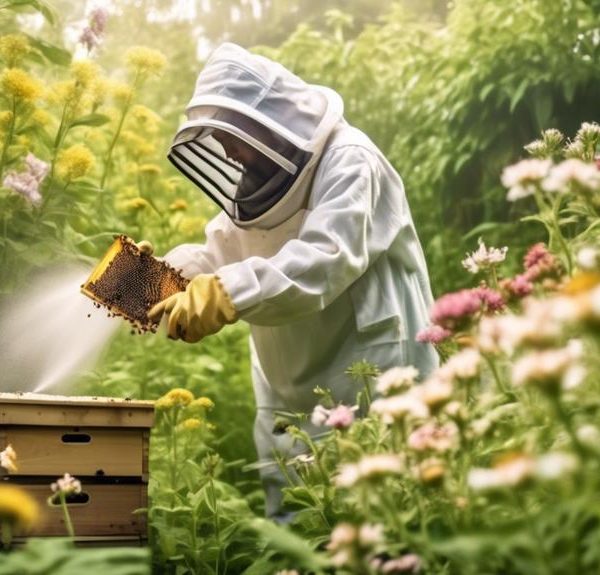Get a glimpse into the space requirements for beekeeping, and discover how factors like hive types, regulations, and foraging areas play a part.
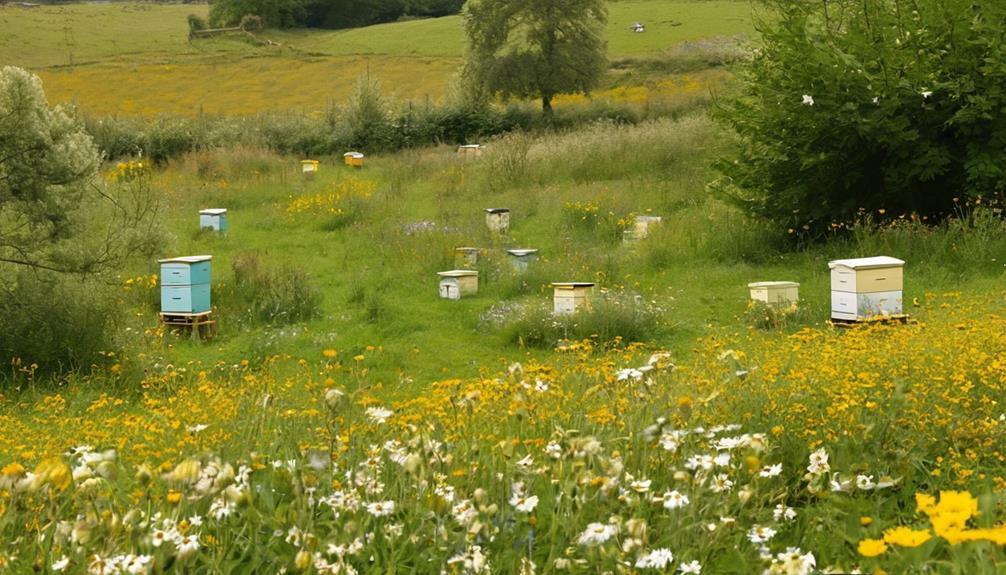
How Much Land Do You Need to Keep Bees?
Ever wondered how much space you'd need to venture into the fascinating world of beekeeping? To answer simply, you don't need acres of land to keep bees. However, the space you'd require is dependent on a variety of factors.
These include, but are not limited to, the type of beehives you plan to use, the number of hives, the local beekeeping regulations, and the available foraging area for the bees. It's worth noting that bees can fly miles to forage, but having a rich, local source of nectar can significantly improve your hive's health and productivity.
But, how does one navigate all these considerations to create an ideal space for beekeeping? Let's explore further.
Key Takeaways
- Assess your land's potential as a bee habitat and ensure it provides a suitable environment year-round.
- Place each hive at least 10 feet apart to minimize congestion and prevent disease spread.
- Ensure a diverse and abundant supply of flowering plants in the vicinity to provide bees with a diverse diet and maximize honey production.
- Research and comply with local beekeeping regulations, including zoning laws, distance requirements, and hive management regulations.
Understanding Beekeeping Basics
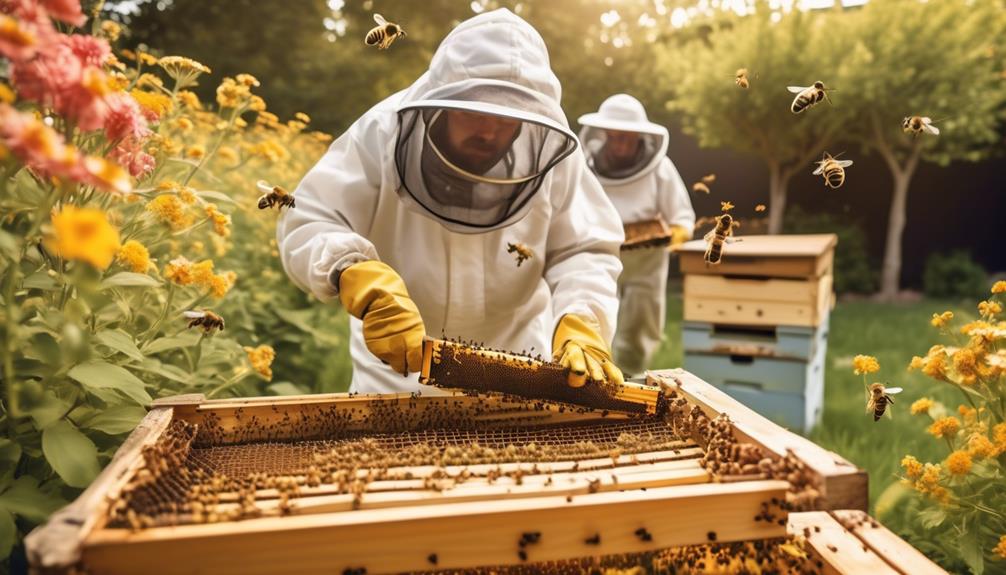
Diving into beekeeping requires a fundamental understanding of its basics, from choosing the right bees to understanding your land's suitability for their habitat. You've got to consider the type of bees you want to keep. Whether you're opting for industrious honeybees or docile solitary bees, knowing their characteristics and needs is paramount.
Next, you must understand your land's potential as a bee habitat. Bees need a diverse diet, just like you. They forage for pollen and nectar from a variety of plants, so you'll need to make sure your property offers this diversity. Don't worry if you're in an urban area; bees can adapt to city life, too.
Water availability is another crucial factor. Bees need water for cooling their hives, food preparation, and hydration. Can you provide a consistent, clean water source?
Lastly, consider the climate. Bees are hardy creatures but they do have their limits. Extreme temperatures can be harmful, so ensure your location can provide a suitable environment year-round.
With these factors in mind, you're well on your way to becoming a successful beekeeper.
Beehive Spacing Requirements
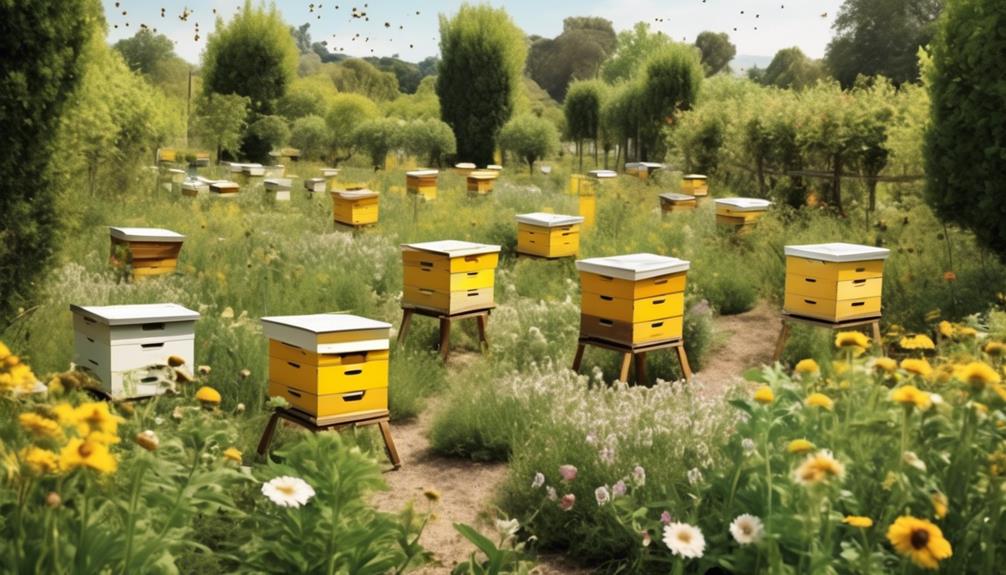
While you've nailed down the basics of beekeeping and understand your land's potential, it's also crucial to consider the spacing requirements for your beehives.
The spacing between your beehives isn't arbitrary. It can greatly influence your bees' health and productivity. You should aim to place each hive at least 10 feet apart from each other. This distance helps to minimize hive congestion and prevent the spread of diseases. It also makes it easier for the bees to identify their own hive, reducing the chance of 'drifting' where bees enter the wrong hive.
Remember, you also need to factor in space for bee traffic, hive maintenance, and inspecting your hives. A good rule of thumb is to allow a minimum of 2-3 feet of space in front of the hives. This allows bees to have a clear flight path and gives you room to work without disturbing them.
Consider the immediate surroundings as well. Avoid placing hives near high-traffic areas or where people and pets frequent. Be mindful of nearby water sources and flowering plants, as they can influence the bees' foraging patterns.
Importance of Foraging Area

Beyond considering hive placement, it's equally critical to evaluate the foraging area available for your bees, as this can significantly impact their health and honey production. A bee's primary food sources are nectar and pollen, which they gather from a variety of flowers within a radius of up to five miles from the hive. Therefore, you must ensure there's a diverse and abundant supply of flowering plants in your vicinity.
You've to remember that bees need a continuous supply of food from early spring through late fall. This means, ideally, there should be plants flowering in succession throughout this period. If your area lacks this biodiversity, you'll need to plant a variety of native flowers, shrubs, and trees that bloom at different times.
Furthermore, the quality and quantity of nectar and pollen available in the foraging area directly affect the quantity and quality of honey produced. Therefore, the foraging area isn't just about the space, but also about the richness and diversity of its flora. So, carefully consider the foraging area when planning to keep bees, as it's integral to their survival and productivity.
Local Beekeeping Regulations

Navigating the maze of local beekeeping regulations is an essential step before you set up your hives. These laws can vary wildly from city to city, and county to county, so it's vitally important that you do your homework. You'll need to check with your local government or agricultural extension office for specific requirements and restrictions.
Some places may have zoning laws that prohibit beekeeping in certain areas or require a specific amount of land. Others might demand a minimum distance between hives and property lines or public spaces. There may also be regulations about hive management, such as mandatory periodic inspections, to ensure the health of the hive and the safety of the public.
You'll also want to look into your state's regulations. Some states require beekeepers to register their hives, while others may have specific regulations regarding the transportation and sale of honey.
Don't forget to consider any HOA or neighborhood rules as well. These can often be more restrictive than local regulations.
Maximizing Small Spaces for Bees
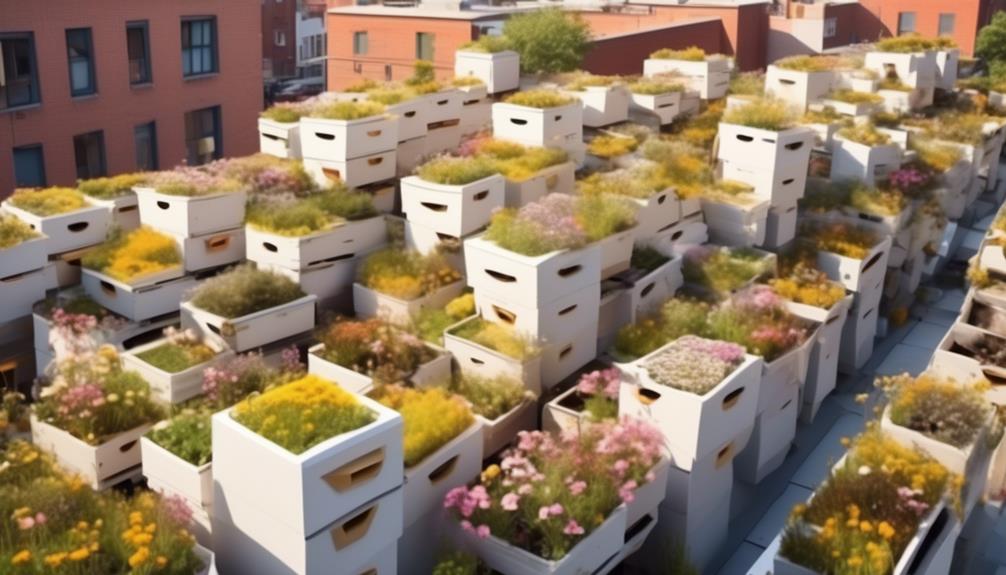
Even if you've found your local regulations to be restrictive, don't be deterred; you can still keep bees successfully, even in small spaces. Here's how to maximize your limited area for beekeeping.
Firstly, consider vertical space. Hive designs such as the Langstroth or Warre offer multiple stackable boxes, allowing a colony to expand upwards instead of outwards. This approach is ideal when horizontal space is limited.
Secondly, strategize your hive placement. Bees need a clear flight path to the hive entrance, so placing hives near walls or hedges can help to direct bee traffic up and away from human spaces. Also, think about sun exposure; hives should ideally face southeast to get morning sun.
Lastly, remember that less can be more. One healthy, well-managed hive can produce more honey than several poorly managed ones. It's better to focus on maintaining a single hive than struggling to manage multiple ones in a cramped area.
In short, smart planning and management can allow successful beekeeping in small spaces. Don't let space constraints prevent you from enjoying this rewarding hobby.
Frequently Asked Questions
What Is the Average Lifespan of a Bee?
You're curious about the average lifespan of a bee, aren't you? Well, it's not as long as you might think.
Worker bees typically live for five to six weeks during the summer, while drones live a bit longer, up to four months.
Queen bees outlive them all, often reaching between two to five years of age.
How Does Weather and Climate Affect Beekeeping?
Weather and climate greatly impact your beekeeping journey. In colder climates, bees cluster together to stay warm. If it's too cold for too long, they may not survive. Conversely, in hot climates, bees might overheat and die.
Extreme weather conditions like heavy rain, wind, or drought can also affect the bees' ability to forage. It's crucial to monitor weather patterns and adjust your beekeeping practices accordingly.
How Much Does It Cost to Start a Beekeeping Project?
Starting a beekeeping project can vary in cost depending on several factors. If you're starting small, you'll spend around $500 for a few hives and basic equipment. However, if you're thinking big, costs can rise to several thousand dollars.
What Are Common Diseases That Affect Bees and How Can They Be Prevented?
Common bee diseases include:
- Varroa mite infestation
- American foulbrood
- Nosema
To prevent these diseases, it is important to:
- Regularly inspect your hive
- Maintain a healthy bee population
- Use appropriate treatments when necessary
Additionally, it is crucial to:
- Keep clean equipment
- Practice good hive management
What Are the Benefits of Beekeeping Apart From Honey Production?
Aside from honey production, beekeeping offers various benefits.
You're helping to boost local plant biodiversity since bees are crucial pollinators.
You're also aiding in the preservation of bee populations, which are currently in decline.
Plus, beekeeping can be therapeutic, as it requires patience and care.
It can also provide beeswax, a valuable product used in candles, cosmetics, and more.
Lastly, it's a chance to learn about these fascinating creatures and their role in our ecosystem.
Conclusion
In conclusion, you don't need acres of land to keep bees. The critical components are sufficient space for hives, adequate foraging areas, and adherence to local regulations.
Even small spaces can be maximized for beekeeping. Thus, understanding the basics and smart planning can make your beekeeping venture successful, regardless of the size of your plot.
Remember, it's not just about the space, but how you utilize it.


